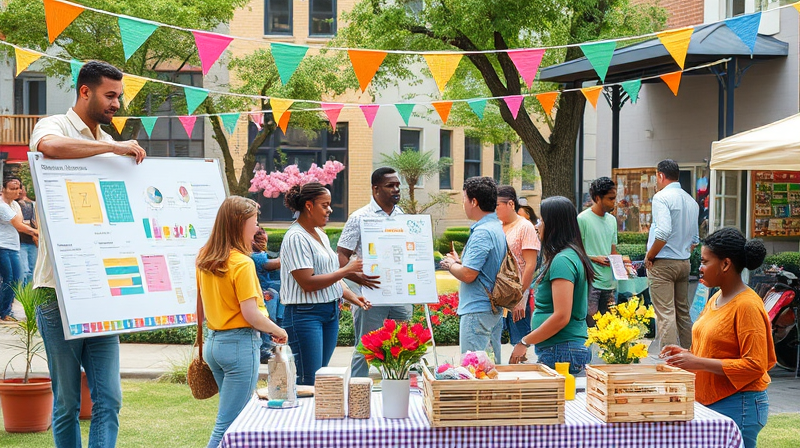Organizing a neighborhood show or activity can be an overwhelmingly exciting experience. This guide is designed to help you coordinate an event that not only entertains but also strengthens community bonds. With careful planning and collaboration, your neighborhood activity can blossom into a signature event that everyone looks forward to each year.
Every successful event begins with a clear vision. Whether your aim is to bring residents together, raise awareness for a worthy cause, or simply create a platform for local talent, the first step is defining your event's purpose and scope. This clarity will guide all of your planning decisions, from selecting the venue to promoting the event.
Essential Steps for a Memorable Neighborhood Event
The planning process is crucial and should not be rushed. Start by creating a comprehensive checklist that ensures every detail is addressed. Here are some proven steps to take:
- Define Your Event's Purpose: Identify the goals of your event. Ask yourself if the event is meant to entertain, educate, or fundraise, and consider how each of these goals can be achieved.
- Establish a Planning Committee: Gather a group of dedicated volunteers from your neighborhood. Each member can take on a specific responsibility like marketing, logistics, or content planning, ensuring no stone is left unturned.
- Set a Date and Secure a Venue: Choose a date that avoids conflicts with other local events. Find a venue that is accessible to all community members and meets your event’s requirements, such as capacity and amenities.
- Create a Budget: Draft a detailed budget highlighting all anticipated expenses. Factor in costs for decorations, equipment, permits, and contingency funds. Reach out to local businesses for potential sponsorships to bolster your funding.
- Develop the Program: Outline a timeline of activities for the event. From performances to interactive activities, an organized schedule keeps the event running smoothly and keeps guests engaged.
Beyond the basics, attention to details such as permits, insurance, and safety measures is paramount to avoid surprises on the day of your event. Remember, the success of any public gathering relies on both vision and preparation.
Obtaining the necessary permits might seem burdensome, but it is a step that ensures your event is compliant with local guidelines and runs without legal or logistical issues. Securing insurance is another safety net, protecting both organizers and participants alike.
Marketing your event effectively is an essential part of the process. Create a vibrant promotional strategy that uses every available tool at your disposal. Harness the power of social media to spread the word and engage potential attendees. Local newsletters, community bulletin boards, and word-of-mouth recommendations are equally important in building excitement.
In the weeks leading up to the event, coordinate logistics meticulously. Arrange for essential equipment such as sound systems, seating, and stage setups. Consider additional amenities like food and beverage stalls that cater to all community tastes, ensuring everyone feels welcome and well-nourished.
No community event shines without the hard work of dedicated volunteers. Recruit volunteers early and provide them with thorough training so that each person understands their role. This preparation is especially crucial for handling any unexpected situations that may arise during the event.
Safety should never be an afterthought. Implement comprehensive safety measures including first aid stations and clear emergency procedures. Make sure that all safety protocols are communicated with the event staff and that reaction strategies are in place in case of emergencies.
On the day of the event, arrive early to set up and to ensure every detail is in place. A final walk-through of the venue can prevent last-minute hurdles. Ensure that volunteers are briefed and that backup plans are ready to be executed if needed. This proactive approach instills confidence among your team and helps guarantee a smooth experience for all attendees.
After the event, take the time to gather feedback from your neighbors, volunteers, and any partners involved in the planning. This critical step allows you to appreciate what worked well and to identify areas for improvement. By evaluating the event, you set the stage for even greater success in future community gatherings.
The beauty of a well-coordinated neighborhood event lies in its power to unite people. It transforms a group of individuals into a community, each contributing to a shared experience of joy and camaraderie. With each successful event, you build lasting relationships that make your neighborhood a more supportive and connected place to live.
Remember, every challenge encountered along the way is an opportunity to learn and grow. Embrace each step with a positive attitude and a commitment to excellence. A well-organized neighborhood event is not just an event—it's a testament to the power of community and the strength of collective effort.
Inspiring leadership, diligent planning, and creative problem-solving are the hallmarks of a truly successful neighborhood activity. As you embark on this exciting journey, keep in mind that each small effort contributes to a larger, impactful legacy. Your dedication and hard work will not only create cherished memories but will also pave the way for future community successes.








